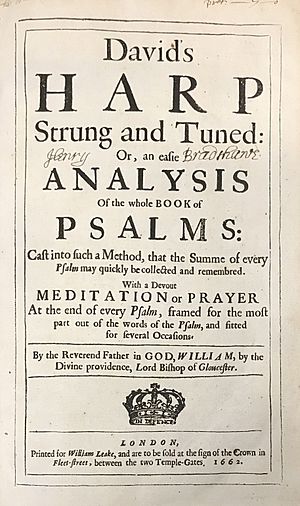William Nicholson (English bishop) facts for kids
Quick facts for kids William Nicholson |
|
|---|---|
| Bishop of Gloucester | |
| Church | Church of England |
| Province | Province of Canterbury |
| Diocese | Diocese of Gloucester |
| Enthroned | 1661 |
| Reign ended | 1672 |
| Orders | |
| Consecration | 1661 by Gilbert Sheldon and Accepted Frewen |
| Personal details | |
| Buried | lady-chapel at Gloucester |
| Spouse | Elizabeth Nicholson |
| Alma mater | Magdalen College, Oxford |
William Nicholson was an important English clergyman who lived from 1591 to 1672. He was a member of a special group called the Westminster Assembly and later became the Bishop of Gloucester. Bishops are leaders in the Christian church, overseeing many churches in a certain area.
Contents
William Nicholson's Early Life and Education
William Nicholson was born on November 1, 1591, in a town called Stratford St. Mary in Suffolk, England. His father, Christopher Nicholson, was a wealthy cloth maker.
When William was just seven years old, in 1598, he became a chorister at Magdalen College, Oxford. This meant he sang in the college choir. He also went to the grammar school connected to the college. He worked hard and earned his first degree (B.A.) in 1611 and a master's degree (M.A.) in 1615.
Becoming a Chaplain and Teacher
From 1612 to 1615, William worked as a "bible clerk" at Magdalen College. In 1614, he was given a church job in New Shoreham, Sussex. He also served as a chaplain at Magdalen College from 1616 to 1618.
William also worked as a chaplain for Henry Percy, 9th Earl of Northumberland. The Earl was held in the Tower of London for many years. During this time, William also taught the Earl's son, Lord Percy.
In 1616, William became the head teacher, or master, of a free school in Croydon. He stayed in this role until 1629.
Life During Difficult Times
In 1626, William Nicholson was given a new church job in Llandilo-Vawr, Carmarthenshire, in Wales. He moved there in 1629. In 1644, he was made an archdeacon of Brecon, which is another important church position.
The Westminster Assembly
A year before, in 1643, William was asked to join the Westminster Assembly. This was a group of religious leaders who met to discuss and reform the Church of England. He was probably invited because of his connection to the Earl of Northumberland. However, William, along with most other Church of England clergy, soon left the Assembly.
Teaching During the English Civil War
During the English Civil War, William lost his church jobs because of the Parliament's actions. To support himself, he started a private school. He ran this school with two other scholars, Jeremy Taylor and William Wyatt (scholar). Their school was at Newton Hall in Llanfihangel Aberbythych, Carmarthenshire. One of their students later became a famous judge named John Powell.
William also worked with Jeremy Taylor to write books defending the Church of England's beliefs and teachings. His books, Exposition of the Apostles' Creed and Exposition of the Church Catechism, were written to help teach his former church members in Llandilo.
Becoming a Bishop
When the king was restored to power in England (this event is called the English Restoration), William Nicholson returned to his church and got his old jobs back. He also received a new position at St. Davids Cathedral.
In 1661, William was made the Bishop of Gloucester. He was officially consecrated (a special ceremony) on January 6 in Henry VII's Chapel. He was allowed to keep his archdeaconry and other church jobs along with his new role as bishop.
Later Years and Legacy
Bishop Nicholson was known for being fair and understanding towards people who didn't fully agree with the Church of England. He even offered a church job to one person if they would agree to follow the church's rules. He also helped George Bull, another important religious figure, get a church position.
In 1663, Bishop Nicholson had a new font (a basin for baptism) built and dedicated in Gloucester Cathedral. He died on February 5, 1672, at the age of 72. He was buried in a special chapel at Gloucester Cathedral, next to his wife, Elizabeth, who had passed away earlier in 1663. A monument was put up by his grandson, Owen Brigstocke, with a special message written by his friend George Bull.
William Nicholson's Published Works
William Nicholson wrote several important books during his lifetime:
- A plain Exposition of the Church Catechism (1655): This book explained the basic teachings of the Church of England.
- Apology for the Discipline of the Ancient Church (1659): This book defended the rules and practices of the early Christian church.
- Plain Exposition of the Apostles' Creed (1661): This book explained the Apostles' Creed, a statement of Christian beliefs.
- David's Harp Strung and Tuned: Or, An Easy Analysis of the Whole Book of Psalms (1662): This book helped people understand the Book of Psalms from the Bible.


